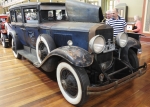Good reasons to preserve a barn find
I wrote about Preservation v Restoration for Fairfax Drive (Drive.com.au) a while back and I keep hearing about fascinating cars that should be preserved rather than restored.
I’m talking about a car that’s in the sort of condition that makes preservation a real option for an owner because it can be brought back to good driving condition and presentation without a bare metal restoration.
One car that recently came to my attention shows the value of keeping a well-preserved car original. It’s a 1929 Cadillac 7-seater that was originally a tourist service car in the Blue Mountains of New South Wales. It later spent over 40 years under a tarpaulin in a farm shed before being discovered and purchased by its current owner. It’s an example of three good reasons to preserve originality.

First, there’s tremendous public interest in seeing real, living history. This Cadillac was on show at the 2014 Motorclassica exhibition in Melbourne and was a huge hit with the crowd. The faded, original paintwork and worn but serviceable upholstery had people spellbound. In fact, the owner later told me the public reaction played a part in his decision to preserve the car.
It’s also important to retain an historical record so we can see and understand how cars were made and what materials were used in different periods. While this applies to everyday production cars and exotics alike, as a car doesn’t need to be out of the ordinary to warrant preservation, a decision can clearly be influenced by rarity, special features or novel manufacturing processes.
The 1929 Cadillac covers all these bases. These models were among the first produced after the legendary Harley Earl established the General Motors Art and Color Section in 1927. They introduced new features like chrome plating, security-plate safety glass and the synchro-mesh gearbox, which eliminated the need to double-clutch to change gears.
Then there’s the question of price. In recent years, preserved originals have been gaining value compared to restored examples, which will continue to make preservation a viable option for current owners and potential buyers. Continuing a recent trend, the second and third top prices paid at a late 2014 Auctions America online auction were for barn finds, a 1960 AC Ace Bristol roadster and a 1953 Aston Martin DB2. You can read more about that auction in this ClassicCars.com update.
And these barn finds just keep on turning up. Another Aston Martin, this one a 1955 DB2/4, was found recently after spending 50 years under a sheet in a Gloucestershire garage, as reported by Classic Cars for Sale UK on 11 January.
Will their new owners preserve them? Given the increasing value being placed on originality and the relative costs of preserving against restoring, it’s quite possible they will. And that’s good news for the automotive industry too. These cars are meant to be driven, so preservation still means getting the engine, gearbox, transmission, suspension and brakes back into top condition. Bodywork will still need to be repaired. And preserving the patina of the duco, enlivening old leather and vinyl and bringing the gleam back to bright work all require skill, knowledge and experience.